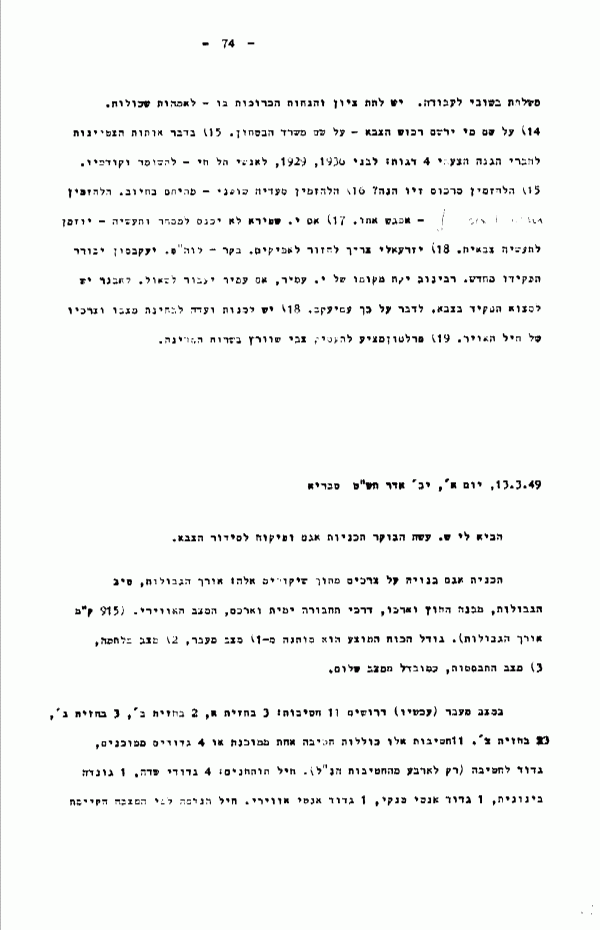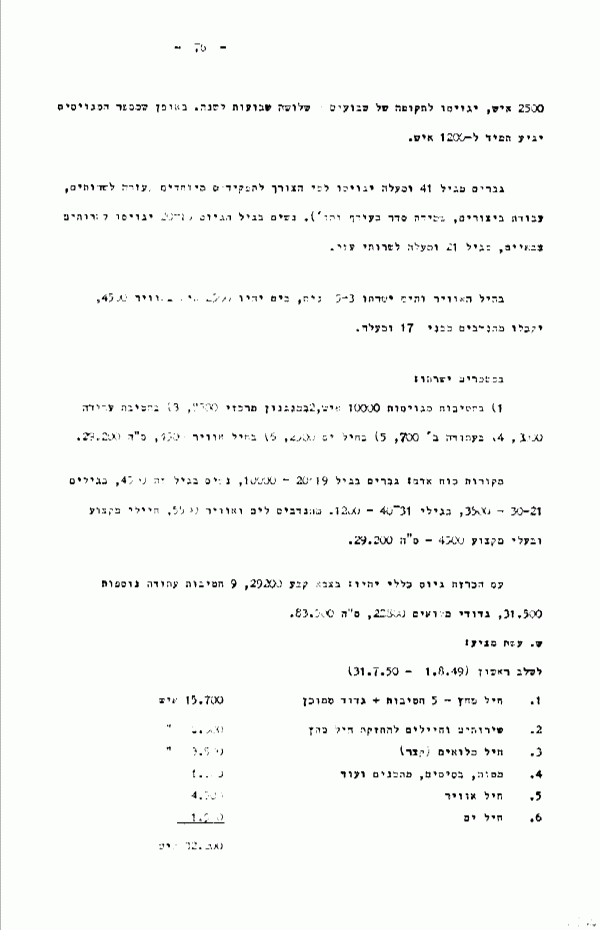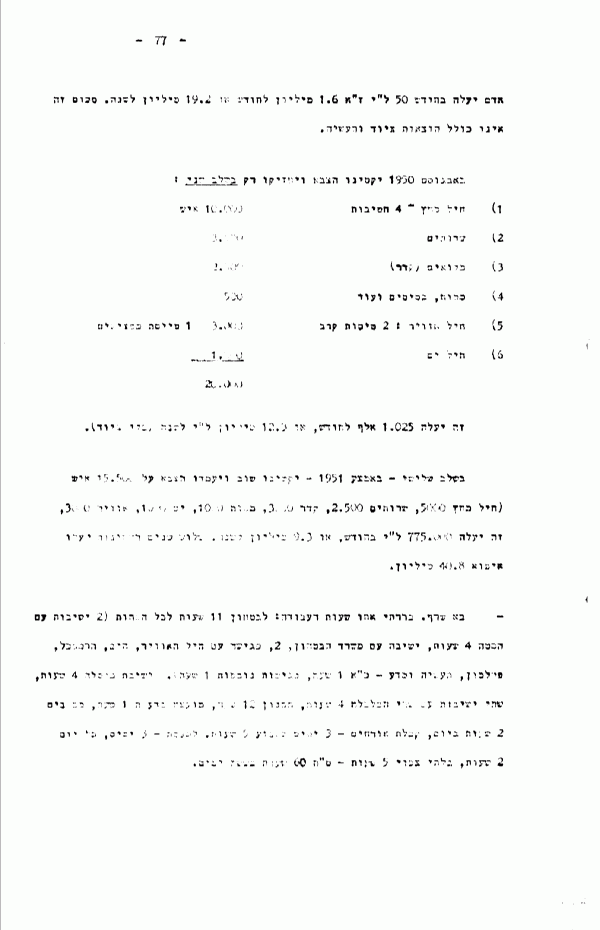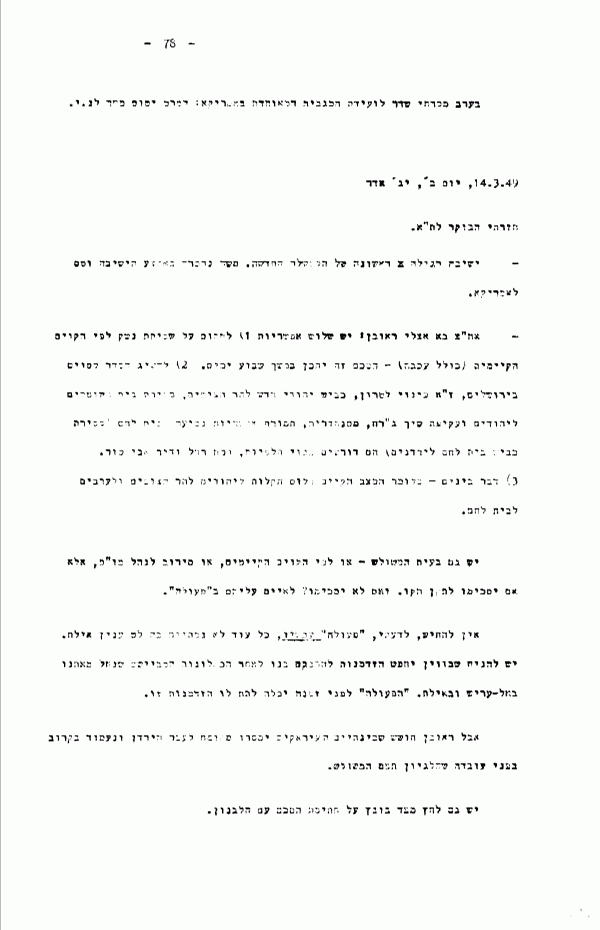Sunday, March 13, 1949, Tiberias
[Shalom] Eshet brought me Operations Department and Oversight Department plans for the army's organization.
The Operations Department plan is based on its needs given the following considerations: the length of the borders, the quality of the borders, the structure and length of the coast, naval transport routes and their length, the aerial situation (915 km of borders). The size of the proposed force is conditional on 1) a state of transition, 2) a state of war, 3) a state of consolidation, as distinct from a state of peace.
In a state of transition (now) 11 brigades are needed: 3 at Front A, 2 at Front B, 3 at Front C, 3 at Front Tz ["Tzafon" - North?]. These 11 brigades include one mechanized brigade or 4 mechanized battalions, a battalion per brigade (only for four of the above brigades). Artillery Corps: 4 field battalions, 1 medium-sized unit, 1 anti-tank battalion, 1 anti-air battalion. Engineering Corps per the current manpower, likewise Signal Corps, Air Force, and Navy. In numbers this means: 11 infantry brigades (11 X 2,500) - 27,500, Artillery Corps 3,870, Engineering 2,551, Signal 2,480, Air [Force] 6,728, Navy 3,300. Total 46,439.
In a state of war: 12 infantry brigades, 4 armored and mechanized brigades, 6 field battalions (144 75 mm cannons, 48 65 mm C.), 1 mid-sized field battalion (24 C.), 1 anti-tank battalion (36 C.), 3 anti-air battalions (84 C.), Engineering Corps, Signal, Air [Force] (290 planes), Navy (3 frigates, 4 corvettes, 3 submarines, boats, Maiales [?, i.e., Italian-made slow-running torpedoes, "pigs" in Italian], etc.) In numbers: 12 brigades (12 X 2,500) 30,000 men, 4 mechanized brigades 10,000, Artillery 7,720, Engineering 7,520, Signal 3,800, Air 9,000, Navy 4,700, total 72,740.
In a state of consolidation: strike force: 4 infantry brigades, 2 armored brigades, Artillery Corps: 3 field battalions 72 75 mm C., 1 mid-sized battalion 24 C., 1 A.T.B. [anti-tank battalion?] 30 C., 1 A.A.B. [anti-air battalion?] 36 C., Engineering, Signal, Navy, and Air, area defense. Reserve: 8 infantry battalions, 2 armored battalions, 3 artillery field battalions, 2 A.A.
In numbers: 4 brigades 10,000, 2 armored 5,000, Artillery 4,207, Engineering 2,906, Signal 2,820, Navy 3,625, Air 7,000, area defense apparatus (on the basis of 8 districts, each staff 160 men, 20 AMAL [military reservists conscripted for limited periods of time] battalions, each with enlisted apparatus of 12 men, and 300 conscripts) 1,340. Total 36,988.
Shaltiel Plan: Presumes limited manpower and limited financial means. Relies on: fortified settlements encircling the state like a belt, enlisted brigades of ages 19-20, each year [age group] 5,000 men, 3 brigades: one of 4,000 men mechanized and armored, 2 motorized brigades, 3,000 each. Reserve brigades from ages 21-30 (3,000 per year [age group]), 10 in number, to serve 5 weeks per year, such that there will always be one enlisted brigade. Reserve B from ages 31-40, each year [age group] 2,500 men, to serve two-three weeks per year such that will always be ,1200 enlisted men.
Men aged 41 and older will be conscripted as needed for special positions (assisting the services, fortification work, maintaining order on the home front, etc.). Women of draft age 19-20 will be conscripted for military services, age 21 and older for auxiliary services.
Service in the Navy and Air Force will be 3-5 years; the Navy will have 2,500 men, the Air [Force] 4,500; volunteers will be accepted from among 17-year-olds and older.
In numbers, [the following] will be in service:
1) In enlisted brigades 10,000 men, 2) In the central apparatus 8,500, 3) In the Labor Brigade 3,000, 4) In Reserve B 700, 5) In the Navy 2,500, 6) In the Air Force 4,500. Total 29,200.
Manpower sources: men aged 19-20 - 10,000, women of this age 4,500, ages 21-30 - 3,500, ages 31-40 - 1,200. Volunteers for the Navy and Air [Force] 5,500 career soldiers and professionals 4,500 - total 29,200.
With the announcement of universal conscription there will be: in the standing army 29,200, 9 additional brigades on reserve 31,500. Reserve battalions 22,800, total 83,500.
S. Eshet proposes:
For the first phase (1 August 1949 - 31 July 1950)
1.
Strike Corps - 5 brigades + mechanized battalion
15,700 men
2.
Services and soldiers to maintain the strike corps
6,000 men
3.
(Brief) reserves corps
3,500 "
4.
Staffs, bases, facilities, etc.
1,000 "
5.
Air Force
4,500 "
6.
Navy
1,500 "
32,200 men
Each man will cost P£ 50 per month, i.e. 1.6 million per month or 19.2 million per year. This sum does not include expenses for equipment and industry.
In August 1950 the army will be reduced in size and in the second phase only [the following] will be maintained:
1.
Strike corps - 4 brigades
10,000 men
2.
Services
3,500
3.
Reserves (cadre [?])
2,500
4.
Staffs, bases, etc.
500
5.
Air Force: 2 combat fleets
3,000
1 bombers fleet
6.
Navy
1,000
20,000
This will cost 1,025,000 per month, or P£ 12.3 million per year (without equipment).
During the third phase - in mid-1950 - the size will be further reduced and the army will stand at 15,500 men (strike corps 5,000, services 2,500, cadre [?] 3,000, staffs 1,000, Navy 1,000, Air [Force] 3,000[)]. This will cost P£ 775,000 per month, or 9.3 million per year. Thus the first three years will cost 40.8 million.
- [Government Secretary Ze'ev] Sherf came. I discussed work hours with him. For defense at least 11 hours (2 meetings with the Staff 4 hours, meeting with the Defense Ministry, meeting with the Air Force, the Navy, the chief of staff, Perlson [Peri - the director-general], industry and science - 1 hour each, additional meetings 1 hour). Government meeting 4 hours, two meetings with the economic ministers 4 hours, planning 12 hours, Science Board 1 hour, letters 2 hours per day, receiving guests 3 days per week 5 hours. For the Knesset - 3 days, 2 hours each day, unexpected 5 hours - total 60 hours over six days.
- In the evening I recorded a broadcast for the United Jewish Appeal conference in America. The film [tape] will be flown to New York tomorrow.













